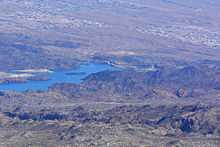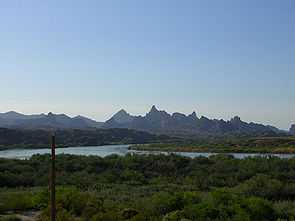Lake Mohave
| Lake Mohave | |
|---|---|
 View of Lake Mohave from the Nevada shore | |
| Location | Mohave County, Arizona / Clark County, Nevada, US |
| Coordinates | 35°26′14″N 114°38′37″W / 35.43722°N 114.64361°WCoordinates: 35°26′14″N 114°38′37″W / 35.43722°N 114.64361°W |
| Type | reservoir |
| Basin countries | United States |
| Surface area | 26,500 acres (10,700 ha) |
| Average depth | 75 ft (23 m) |
| Water volume | 246,100,000 m3 |
| Surface elevation | 647 ft (197 m) |
Lake Mohave is a reservoir formed by Davis Dam on the Colorado River, which defines the border between Nevada and Arizona in the United States. The lake lies at an elevation of 647 feet (197 m) near Laughlin, Nevada, Searchlight, Nevada, Cottonwood Cove, Nevada, and Bullhead City, Arizona, The Lake starts at the Hoover Dam on the Colorado River and runs to the Davis Dam. The lake and adjacent lands forming its shoreline are part of the Lake Mead National Recreation Area administered by the U.S. National Park Service. Lake Mohave encompasses 28,260 acres of water.[1]
Resorts and recreation
There are two resorts on Lake Mohave: Cottonwood Cove and Lake Mohave Resort. Both resorts have lodging, campgrounds, restaurant, store, and marina with gas dock.[2] Popular recreational activities in Lake Mohave are swimming, kayaking, fishing, boating, and skiing. There are kayaking, scuba diving, and fishing supplies in Bullhead City, which borders the southernmost point of Lake Mohave. Lake Mohave offers year-round recreational opportunities. Its clear water caters to boaters, swimmers, and fishermen while its desert rewards hikers, wildlife photographers, and roadside sightseers. It is also home to thousands of desert plants and animals, adapted to survive in an extreme place where rain is scarce and temperatures soar.[3]
Scuba diving
Lake Mead National Recreation Area, which encompasses Lake Mead, Lake Mohave and a portion of the Colorado River, offers good diving opportunities for both novice and advanced divers.[4] At Lake Mohave, divers can explore Black Canyon, which has excellent diving conditions. Advanced divers can check out Ringbolt Rapids, where swift water makes for an additional challenge. Work Barge on the Arizona side has a 38-foot tow barge that sank in 1946. Cabinsite Point has two boat wrecks to view.
Fish species

Native fish
Introduced fish
- Rainbow trout
- Largemouth bass
- Smallmouth bass
- Striped bass
- Crappie
- Sunfish
- Channel catfish
- Common carp
- Threadfin shad
Fish enhancement projects

The non-native sport fishery in Lake Mohave is enhanced by a Nevada Division of Wildlife program which places artificial habitat bundles in coves around the reservoir.[5] The habitats are composed primarily of bundled salt cedar trees attached to wooden pallets. When placed in the water, the structures create cover for sport fish.
Additionally, Lake Mohave contains one of the largest and most genetically diverse population of razorback sucker remaining in the wild.[6] Each spring, a multi-agency group of fish biologists use underwater lights to collect approximately 30,000 razorback sucker larvae along the shore of Lake Mohave, which would otherwise be eaten by introduced fishes.[7] Larvae are then transported by boat to Willow Beach National Fish Hatchery where they grow in protected raceways for up to three years. When individuals have reached approximately 14 inches in length, they are released back into Lake Mohave in order to avoid predation[8] by larger, introduced game fish such as striped bass.[9]
Gallery
-

Arizona S. Telephone Cove beach.
-
Six Mile Cove at Lake Mohave, Nevada.
-

Aerial view of the northern end of Lake Mohave, just south of Davis Dam.
See also
References
- ↑ "Lake Mohave Vacation Info". Lakelubbers. Retrieved 2012-10-29.
- ↑ "Lake Mohave info". Riverlakes.com. Retrieved 2012-10-29.
- ↑ "Lake Mead National Recreation Area - Lake Mead National Recreation Area". Nps.gov. 2012-08-24. Retrieved 2012-10-29.
- ↑
- ↑ "2011 Nevada Fishing Guide". Nevada Division of Wildlife. pp. 14–15.
- ↑ Dowling, T.E.; Marsh, P.C., Kelsen, A.T., and C.A. Tibbets (2005). "Genetic monitoring of wild and repatriated populations of endangered razorback sucker (Xyrauchen texanus, Catostomidae, Teleostei) in Lake Mohave, Arizona-Nevada". Molecular Ecology 14 (1): 123–135. doi:10.1111/j.1365-294X.2004.02408.x.
- ↑ Marsh, P.C.; Langhorst, D.R. (1988). "Feeding and fate of wild larval razorback sucker". Environmental Biology of Fishes 21 (1): 59–67. doi:10.1007/BF02984443.
- ↑ Marsh, P.C.; Pacey, C.A., and B.R. Kesner (2003). "Decline of the Razorback Sucker in Lake Mohave, Colorado River, Arizona and Nevada". Transactions of the American Fisheries Society 132 (6): 1251–1256. doi:10.1577/T02-115.
- ↑ Karam, A.P.; Marsh, P.C. (2010). "Predation of Adult Razorback Sucker and Bonytail by Striped Bass in Lake Mohave, Arizona—Nevada". Western North American Naturalist 70 (1): 117–120. doi:10.3398/064.070.0113.
External links
| Wikimedia Commons has media related to Lake Mohave. |
- National Park Service, Lake Mead National Recreation Area
- Arizona Boating Locations Facilities Map
- Arizona Fishing Locations Map
- Cultural History of Lake Mohave
| ||||||||||||||||||||||||||||||||||||||||||||||



